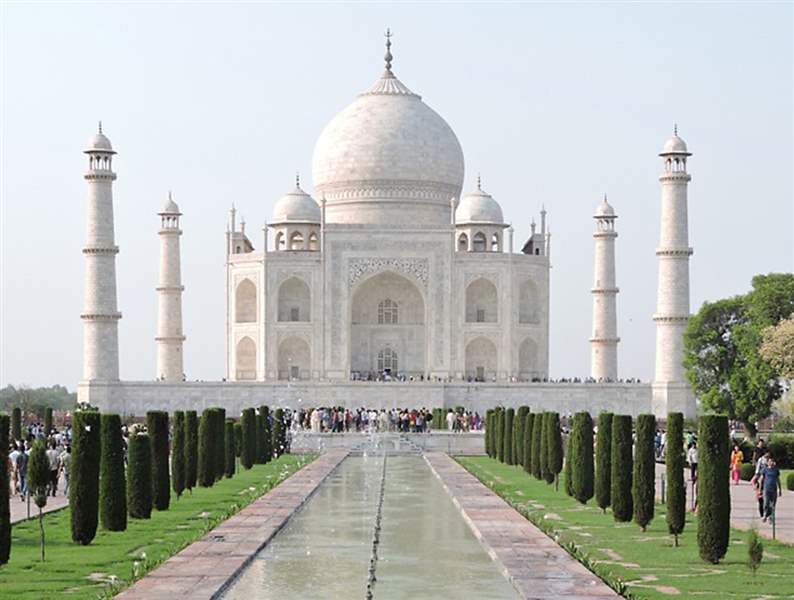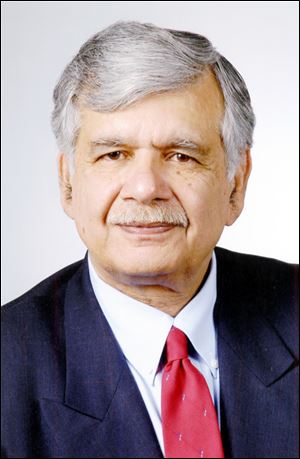
POSTCARD FROM INDIA
More than 3 centuries old, Taj Mahal still shines
5/11/2014
Construction of the Taj Mahal occurred between 1632 and 1653.
PHOTO COURTESY OF S. AMJAD HUSSEIN

Hussain
AGRA, INDIA — It has been a train journey of a lifetime. The luxury train Palace on Wheels made a weeklong run from New Delhi to some of the fabled cities of the western Indian state of Rajasthan and returned to New Delhi via Agra.
Along the way there were stops at Jaipur, Chittorgarh, Udaypur, Jodepur, and Jaseselmer.
Every town has history, some of it going back millennia or longer. Being on the fabled spice route, Rajasthan and its various kingdoms were coveted by many a ruler of India, and many an epic battle were fought in these lands.
Tales of bravery, sacrifice, intrigue, and unfulfilled love abound; some true, others exaggerated. But they invariably gave rise to myths and legends and add color to its storied past. These tales have become part of the folklore of the region and have entered into the subconscious of the people of Rajasthan.
Every stop along the way opened up new vistas to the backdrop of those ancient tales, but one of the most important highlights of the journey was a day at the Taj Mahal in Agra. I had visited the place in 1986 and had written a cover story for Toledo Magazine in the Sunday Blade.
The Taj Mahal is still serene, still sublimely beautiful, and a wonder to look at. Twenty-five years ago, environmental pollution was marring its face. Now, no fossil-fueled vehicles are allowed within a few miles, and visitors ride electric vehicles to the monument. Its grounds are cleaner, with no family picnics allowed on the grounds — a common sight in the past.

Construction of the Taj Mahal occurred between 1632 and 1653.
The story of the Taj Mahal is well-known and rather familiar. Shah Jahan, the Moghul emperor of 17th century India, lost his favorite wife, Mumtaz Mahal, in childbirth in 1631. Heart stricken, the emperor ordered the building of a mausoleum for her on the banks of the Yumana River in the city of Agra.
Twenty thousand men and 1,000 elephants worked for 22 years to complete the masterpiece. Artisans came not only from the length and breadth of India, but also from as far away as Persia, Turkey, and Central Asia. The underlying theme of the extensive decorative work was to create a building that seamlessly incorporated the elements of Indian, Parsian, and broader Islamic art and architecture.
The building is a perfect cube and looks the same from all sides. The four minarets are slightly tilted away from the building to prevent them from falling on the building in case of a big earthquake.
Throughout the building, the marble walls are decorated with intricate inlay of precious and semi-precious stones. Keeping with strict Islamic tradition there is no representation of human or animal images. Instead, the decorative work shows either geometric designs or flowering plants. The same inlay technique was used to inscribe passages from the Qur’an on the entry way and the three side doors of the building.
The dome almost looks translucent. It absorbs the light rather than reflect it, thus making it serene in any light. In the subtle light of a full moon, the whole monument glows.
Architectural symmetry is the hallmark of Mughal buildings. A mosque built to the west of the Taj Mahal created asymmetry. So a mirror image building, used as the guesthouse, was built on the east side. The building is called Jawaab in Urdu and Hindi, meaning the Answer in Hindi and Urdu (to the asymmetry).
The identity of the architect who designed and supervised the masterpiece is not known. Available evidence points to one of the two men by the names of Ustad Isa Shirazi and Ustad Ahmad Lahauri. However, nothing much is known about them.
At the completion in 1652, the remains of queen Mumtaz Mahal were laid to rest in the mausoleum.
But the story did not end there. Four years later, in 1658, Emperor Shah Jahan was deposed by his son Aurangzeb and was imprisoned in Agra Fort a few miles from the Taj Mahal. The deposed king spent the remaining eight years of his life as a prisoner gazing at the masterpiece he had created for his beloved wife.
Upon his death in 1666, Shah Jahan was laid to rest in the monument by his wife’s side.

The Taj Mahal has been celebrated as a symbol of eternal love, and much has been written about the dedication of a man who expressed his love for a woman in such an elegant and exquisite way.
But there have also been those who look at the monument with different eyes.
Sahir Ludhianvi, a celebrated Urdu language poet from India, wrote a poem about the Taj Mahal in the early 1950s in which he drew a parallel between the love expressed by the haves and have-nots. It says in part: “O my love, let us meet not at Taj but somewhere else.
“Uncounted numbers of people have loved in this world, Who could say theirs was not the true love?
“But they remain uncelebrated and unsung, Because they were also poor like the two of us Look at the vast manicured lawns and exquisite gardens on the bank of Yumana River Look at the beautiful arches, the doors and the ornate niches, and think, Just because he could, a king used his wealth to make fun of the love of poor like us.
“Please my love, let us meet some place else."
Dr. S. Amjad Hussain is a retired Toledo surgeon. Contact him at: aghaji@bex.net